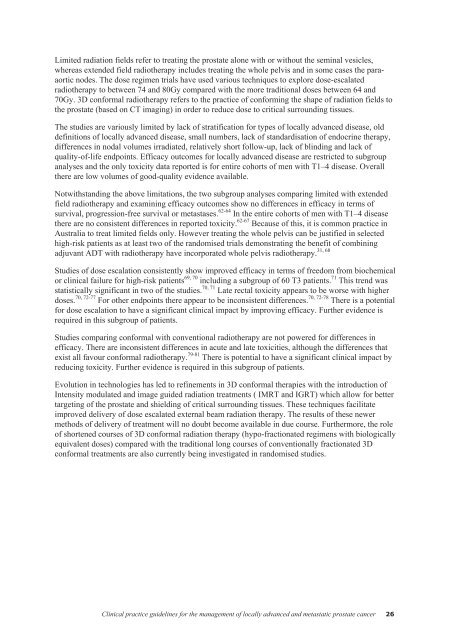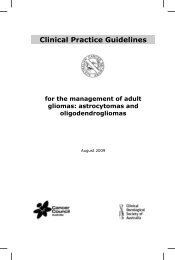Clinical Practice Guidelines for the management of locally advanced ...
Clinical Practice Guidelines for the management of locally advanced ...
Clinical Practice Guidelines for the management of locally advanced ...
Create successful ePaper yourself
Turn your PDF publications into a flip-book with our unique Google optimized e-Paper software.
Limited radiation fields refer to treating <strong>the</strong> prostate alone with or without <strong>the</strong> seminal vesicles,<br />
whereas extended field radio<strong>the</strong>rapy includes treating <strong>the</strong> whole pelvis and in some cases <strong>the</strong> paraaortic<br />
nodes. The dose regimen trials have used various techniques to explore dose-escalated<br />
radio<strong>the</strong>rapy to between 74 and 80Gy compared with <strong>the</strong> more traditional doses between 64 and<br />
70Gy. 3D con<strong>for</strong>mal radio<strong>the</strong>rapy refers to <strong>the</strong> practice <strong>of</strong> con<strong>for</strong>ming <strong>the</strong> shape <strong>of</strong> radiation fields to<br />
<strong>the</strong> prostate (based on CT imaging) in order to reduce dose to critical surrounding tissues.<br />
The studies are variously limited by lack <strong>of</strong> stratification <strong>for</strong> types <strong>of</strong> <strong>locally</strong> <strong>advanced</strong> disease, old<br />
definitions <strong>of</strong> <strong>locally</strong> <strong>advanced</strong> disease, small numbers, lack <strong>of</strong> standardisation <strong>of</strong> endocrine <strong>the</strong>rapy,<br />
differences in nodal volumes irradiated, relatively short follow-up, lack <strong>of</strong> blinding and lack <strong>of</strong><br />
quality-<strong>of</strong>-life endpoints. Efficacy outcomes <strong>for</strong> <strong>locally</strong> <strong>advanced</strong> disease are restricted to subgroup<br />
analyses and <strong>the</strong> only toxicity data reported is <strong>for</strong> entire cohorts <strong>of</strong> men with T1–4 disease. Overall<br />
<strong>the</strong>re are low volumes <strong>of</strong> good-quality evidence available.<br />
Notwithstanding <strong>the</strong> above limitations, <strong>the</strong> two subgroup analyses comparing limited with extended<br />
field radio<strong>the</strong>rapy and examining efficacy outcomes show no differences in efficacy in terms <strong>of</strong><br />
survival, progression-free survival or metastases. 62-64 In <strong>the</strong> entire cohorts <strong>of</strong> men with T1–4 disease<br />
<strong>the</strong>re are no consistent differences in reported toxicity. 62-67 Because <strong>of</strong> this, it is common practice in<br />
Australia to treat limited fields only. However treating <strong>the</strong> whole pelvis can be justified in selected<br />
high-risk patients as at least two <strong>of</strong> <strong>the</strong> randomised trials demonstrating <strong>the</strong> benefit <strong>of</strong> combining<br />
31, 68<br />
adjuvant ADT with radio<strong>the</strong>rapy have incorporated whole pelvis radio<strong>the</strong>rapy.<br />
Studies <strong>of</strong> dose escalation consistently show improved efficacy in terms <strong>of</strong> freedom from biochemical<br />
or clinical failure <strong>for</strong> high-risk patients 69, 70 including a subgroup <strong>of</strong> 60 T3 patients. 71 This trend was<br />
statistically significant in two <strong>of</strong> <strong>the</strong> studies. 70, 71 Late rectal toxicity appears to be worse with higher<br />
doses. 70, 72-77 For o<strong>the</strong>r endpoints <strong>the</strong>re appear to be inconsistent differences. 70, 72-78 There is a potential<br />
<strong>for</strong> dose escalation to have a significant clinical impact by improving efficacy. Fur<strong>the</strong>r evidence is<br />
required in this subgroup <strong>of</strong> patients.<br />
Studies comparing con<strong>for</strong>mal with conventional radio<strong>the</strong>rapy are not powered <strong>for</strong> differences in<br />
efficacy. There are inconsistent differences in acute and late toxicities, although <strong>the</strong> differences that<br />
exist all favour con<strong>for</strong>mal radio<strong>the</strong>rapy. 79-81 There is potential to have a significant clinical impact by<br />
reducing toxicity. Fur<strong>the</strong>r evidence is required in this subgroup <strong>of</strong> patients.<br />
Evolution in technologies has led to refinements in 3D con<strong>for</strong>mal <strong>the</strong>rapies with <strong>the</strong> introduction <strong>of</strong><br />
Intensity modulated and image guided radiation treatments ( IMRT and IGRT) which allow <strong>for</strong> better<br />
targeting <strong>of</strong> <strong>the</strong> prostate and shielding <strong>of</strong> critical surrounding tissues. These techniques facilitate<br />
improved delivery <strong>of</strong> dose escalated external beam radiation <strong>the</strong>rapy. The results <strong>of</strong> <strong>the</strong>se newer<br />
methods <strong>of</strong> delivery <strong>of</strong> treatment will no doubt become available in due course. Fur<strong>the</strong>rmore, <strong>the</strong> role<br />
<strong>of</strong> shortened courses <strong>of</strong> 3D con<strong>for</strong>mal radiation <strong>the</strong>rapy (hypo-fractionated regimens with biologically<br />
equivalent doses) compared with <strong>the</strong> traditional long courses <strong>of</strong> conventionally fractionated 3D<br />
con<strong>for</strong>mal treatments are also currently being investigated in randomised studies.<br />
<strong>Clinical</strong> practice guidelines <strong>for</strong> <strong>the</strong> <strong>management</strong> <strong>of</strong> <strong>locally</strong> <strong>advanced</strong> and metastatic prostate cancer<br />
26



